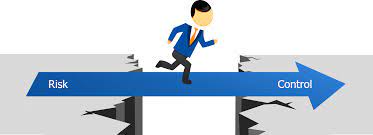RISK MANAGEMENT TECHNIQUES
Risk Management Techniques can be classified broadly as either risk control or risk financing.
Risk control refers to techniques that reduce the frequency or severity of losses.
Risk financing refers to techniques that provide for the funding of losses.
Risk managers typically use a combination of techniques for treating each loss exposure.
RISK CONTROL – RISK MANAGEMENT TECHNIQUES

Risk control is a generic term to describe techniques for reducing the frequency or severity of losses. Major risk-control techniques include the following:
- Avoidance
- Loss prevention
- Loss reduction
RISK AVOIDANCE

Avoidance is one of the important and widely used risk management techniques. For example, you can avoid the risk of being mugged in a high crime area by staying out of the vicinity; you can avoid the risk of divorce by not marrying; and a business firm can avoid the risk of being sued for a defective product by not producing the product.
LOSS PREVENTION

Loss prevention aims at reducing the probability of loss so that the frequency of losses is reduced. Several examples of personal loss prevention can be given. Auto accidents can be reduced if motorists take a safe-driving course and drive defensively. The number of heart attacks can be reduced if individuals control their weight, stop smoking, and eat healthy diets.
Loss prevention is also important for business firms.
For example, strict security measures at airports and aboard commercial flights can reduce acts of terrorism. Boiler explosions can be prevented by periodic inspections by safety engineers; occupational accidents can be reduced by the elimination of unsafe working conditions and by strong enforcement of safety rules; and fires can be prevented by forbidding workers to smoke in a building where highly flammable materials are used. In short, the goal of loss prevention is to reduce the probability that losses with occur.
LOSS REDUCTION

Strict loss prevention efforts can reduce the frequency of losses; however, some losses will inevitably occur. Thus, the second objective of loss control is to reduce the severity of a loss after it occurs.
For example, a department store can install a sprinkler system so that a fire will be promptly extinguished, thereby reducing the severity of loss; a plant can be constructed with fire-resistant materials to minimize fire damage; fire doors and fire walls can be used to prevent a fire from spreading; and a community warning system can reduce the number of injuries and deaths from an approaching tornado.
From the viewpoint of society, loss control is highly desirable for two reasons.
First, the indirect costs of losses may be large, and in some instances can easily exceed the direct costs. For example, a worker may be injured on the job. In addition to being responsible for the worker’s medical expenses and a certain percentage of earnings (direct costs), the firm may incur sizable indirect costs: a machine may be damaged and must be repaired; the assembly line may have to be shut down; costs are incurred in training a new worker to replace the injured worker; and a contract may be cancelled because goods are not shipped on time. By preventing the loss from occurring, both indirect costs and direct costs are reduced.
Second, the social costs of losses are reduced. For example, assume that the worker in the preceding example dies from the accident. Society is deprived forever of the goods and services the deceased worker could have produced. The worker’s family loses its share of the worker’s earnings and may experience considerable grief and economic insecurity. And the worker may personally experience great pain and suffering before dying. In short, these social costs can be reduced through an effective loss-control program.
RISK FINANCING – RISK MANAGEMENT TECHNIQUES

Risk financing refers to techniques that provide for the payment of losses after they occur. Major risk-financing techniques include the following:
- Retention
- Noninsurance transfers
- Insurance
RISK RETENTION
Retention is one of the important risk management techniques. Retention means that an individual or a business firm retains part of all of the losses that can result from a given risk. Risk retention can be active or passive.

Active Retention: Active risk retention means that an individual is consciously aware of the risk and deliberately plans to retain all or part of it. For example, a motorist may wish to retain the risk of a small collision loss by purchasing an auto insurance policy with a $500 or higher deductible.
A homeowner may retain a small part of the risk of damage to the home by purchasing a homeowners policy with a substantial deductible. A business firm may deliberately retain the risk of petty thefts by employees, shoplifting, or the spoilage of perishable goods by purchasing a property insurance policy with a sizeable deductible. In these cases, a conscious decision is made to retain part or all of a given risk.
Active risk retention is used for two major reasons. First, it can save money. Insurance may not be purchased, or it may be purchased with a deductible; either way, there is often substantial savings in the cost of insurance. Second, the risk may be deliberately retained because commercial insurance is either unavailable or unaffordable.
Passive Retention: Risk can also be retained passively. Certain risks may be unknowingly retained because of ignorance, indifference, laziness, or failure to identify an important risk. Passive retention is very dangerous if the risk retained has the potential for financial ruin.
For example, many workers with earned incomes are not insured against the risk of total and permanent disability. However, the adverse financial consequences of total and permanent disability generally are more severe than the financial consequences of premature death. Therefore, people who are not insured against this risk are using the technique of risk retention in a most dangerous and inappropriate manner.
SELF INSURANCE

Self-insurance is a special form of planned retention by which part or all of a given loss exposure is retained by the firm. Another name for self-insurance is self-funding, which expresses more clearly the idea that losses are funded and paid for by the firm. For example, a large corporation may self-insure or fund part or all of the group health insurance benefits paid to employees. Self-insurance is widely used in corporate risk management programs primarily to reduce both loss costs and expenses. There are other advantages as well.
In summary, risk retention has an important place among risk management techniques, especially in modern corporate risk management programs. Risk retention, however, is appropriate primarily for high-frequency, low-severity risks where potential losses are relatively small. Except under unusual circumstances, risk retention should not be used to retain low-frequency, high-severity risks, such as the risk of catastrophic medical expenses, long-term disability, or legal liability.
NON-INSURANCE TRANSFERS
Noninsurance transfers are another technique for managing risk. The risk is transferred to a party other than an insurance company. A risk can be transferred by several methods, including:
- Transfer of risk by contracts
- Hedging price risks
- Incorporation of a business firm
Transfer of Risk by Contracts
Undesirable risks can be transferred by contracts. For example, the risk of a defective television or stereo set can be transferred to the retailer by purchasing a service contract, which makes the retailer responsible for all repairs after the warranty expires. The risk of a rent increase can be transferred to the landlord by a long-term lease. The risk of a price increase in construction costs can be transferred to the builder by having a guaranteed price in the contract. Finally, a risk can be transferred by a hold harmless clause.
For example, if a manufacturer of scaffolds inserts a hold-harmless clause in a contract with a retailer, the retailer agrees to hold the manufacturer harmless in case a scaffold collapses and someone is injured.
Hedging Price Risks
Hedging price risks is another example of risk transfer. Hedging is a technique for transferring the risk of unfavourable price fluctuations to a speculator by purchasing and selling futures contracts on an organized exchange, such as the Chicago Board of Trade or New York Stock Exchange.
For example, the portfolio manager of a pension fund may hold a substantial position in long-term United States Treasury bonds. If interest rates rise, the value of the Treasury bonds will decline. To hedge that risk, the portfolio manager can sell Treasury bond futures. Assume that interest rates rise as expected, and bond prices decline.
The value of the futures contract will also decline, which will enable the portfolio manager to make an offsetting purchase at a lower price. The profit obtained from closing out the futures position will partly or completely offset the decline in the market value of the Treasury bonds owned. Of course, interest rates do not always move as expected, so the hedge may not be perfect. Transaction costs also are incurred.
However, by hedging, the portfolio manager has reduced the potential loss in bond prices if interest rates rise. Incorporation of a Business Firm Incorporation is another example of risk transfer. If a firm is a sole proprietorship, the owner’s personal assets can be attached by creditors for satisfaction of debts. If a firm incorporates, personal assets cannot be attached by creditors for payment of the firm’s debts. In essence, by incorporation, the liability of the stockholders is limited, and the risk of the firm having insufficient assets to pay business debts is shifted to the creditors.
Insurance

For most people, insurance is the most practical method for handling major risks. Although private insurance has several characteristics, three major characteristics should be emphasized. First, risk transfer is used because a pure risk is transferred to the insurer. Second, the pooling technique is used to spread the losses of the few over the entire group so that average loss is substituted for actual loss. Finally, the risk may be reduced by application of the law of large numbers by which an insurer can predict future loss experience with greater accuracy.
| Risk management | Risk management process | Risk Management Plan |
| Types of risk in insurance | Risk management tools | What is risk |